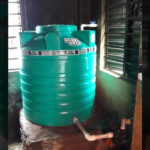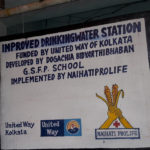Construction of drinking water station in Dogachia Bidyarthi Bhaban GSFP School Develop healthy and hygienic living style among the students of selected primary school of North 24 parganas.
Objectives:
1. Develop improved Drinking Water Station.
2. Maintenance and practice of Personal Hygiene
3. Provide safe drinking water
Water, Sanitation and Hygiene (WASH) Project
Context:
It is an established fact that investments in school sanitation and hygiene education together can create improved learning environments, thereby facilitating increased attendance and retention of students. The impact it is most pronounced among girl students, when their special needs of adequacy and privacy are catered to.
Toilets are being planned to provide good sanitation to girl students early in life. The toilet blocks shall ensure that the girls are not only exposed to hygienic sanitation and toilet training, but the privacy of separate toilets for their use. The thrust of this project is to ensure the dignity of girls, and inculcate respect for their dignity among co-boy students. It is a disgrace and embarrassing for girls to attend schools without toilets or which have toilets that are unusable thus either absenting classes several days in a month or running home to use toilets.
Combining development of infrastructural facilities with awareness building on the importance of proper hygiene and ways to prevent water related ailments is imperative. Also important and needed is an evolved attitude among fellow boy students and adults i.e. teachers, school authorities and parents, supporting the initiatives with a positive disposition towards safe water and sanitation and healthy habits of children. The overall average for school sanitation coverage of amenities that are functional and usable is about 22% in West Bengal.
Project Premise:
Investing in girls’ education is the most “inclusive cause” essential for a more prosperous and responsible society. When girls get educated, it benefits them and the community as a whole. A key focus area for UWK is both social and economic empowerment to help change circumstances faced by girls from disadvantageous backgrounds. This project aims to keep girls engaged in the classroom and complete studies.
Rationale:
In schools, the figures show a reasonable coverage for both water and sanitation, but without stating the appropriateness in terms of adequacy, access and cultural acceptance or use. Open air defecation and urinary discharge is an extremely unhygienic practice, spoiling the school’s environment. Apart from this, the practice creates a complex in the girl child who is always having to hide for something as basic as using a toilet. With most school toilets (combined in co-ed schools), girl children collect water from nearby ponds
to use. Lack of adequate water impedes hygienic behaviour, keeping toilets dirty and unfit for use. Boys find it easier to cope as they are habituated to open urination and defecation around school premises. But girls find it difficult to manage and prefer staying away from school.
Problems for girls and lady teachers are more pronounced during their menstruation days. Poorly designed infrastructure, without considerations for disposal of menstrual waste, pose challenges that are both hazardous to health and psychologically challenging. It is not surprising that absenteeism is higher among girl students in these schools. The sanitation crisis for girls can be summed up in one word “dignity”. Around the world, less than one girl has access to a toilet. This impacts on health and puts their safety at risk. About half of girls worldwide attend school without toilets. The lack of privacy causes many girls to drop out when they reach puberty, and lack of access to basic and safe sanitation also has its repercussions on girls’ education.
Thus, adolescent girls are the most affected. Around age twelve, many girls start menstruating and it is extremely necessary for them to have a private space for washing, cleaning, and using the toilet. Many schools especially in the suburbs and rural areas lack these required sanitary facilities. Menstruation can last anywhere from five to seven days, and the girls end up staying at home and absenting schools lacking facilities to change and clean themselves. Missing 5-7 days of school every month adversely affects their education and making them fall behind in their classes.
Girls with poor menstruation hygiene are more prone to abdominal pains, urine infections and other diseases. Also, girls with health problems are less likely to be able to concentrate on their studies and do well in school. For instance, a girl who has health problems due to poor menstruation hygiene will probably miss around three days of school, which means she may miss a total of 10 days of school every month.
Targeted Beneficiaries:
- Primary school students
- High schools students
- Adolescent girls in high schools
Targeted locations:
South 24 parganas districts of West Bengal which are prone to trafficking of girls for domestic work, marriage and prostitution
Also schools within Kolkata as feasible
Project Goals:
Provide privacy & uphold the dignity of girls
Improve sanitation, hygiene and habits of girl students, who in turn will inspire parents to have toilets in their home so that women do not have to go to the fields
Project Objectives:
Develop or renovate sanitary blocks for students who still have little or no access to sanitary facilities within their school with proper light and ventilation and improved drainage system
Provide adequate supply of running water and wash water to sanitary blocks in the schools to support hygienic habits and safe drinking water
Sanitary education to create awareness on the importance of sanitary hygiene in preventing water borne diseases among the students and their parents so that a common need of such habits is perceived and they start practicing the safety and hygienic measures in their daily lives
Ensure the delivery of safe drinking water through installation of purifier to maintain the quality especially E. Coli bacteria free
Promote change room with incinerator for adolescent girls to feel secured, comfortable and have privacy in the school during menstruation
Expected Project Outcome:
- Improved sanitary infrastructure in schools for girls and co-ed schools with separate blocks for girls
- Increased girls’ attendance in school
- Reduce girls drop out from school due to inadequate toilet facilities
- Sanitary education
- Good hygienic practice in among students from diseases
Key activities of the program within projected duration:
- Construct & renovate separate sanitary blocks in the high school
- Organize meetings with the school management committee, teachers and mothers’ group regarding maintenance of the developed infrastructure
- Develop and distribute innovative hygiene education materials and IEC materials to target audience
- Organize block level advocacy with officials, community participation and cost sharing in the program
- Mobilize school and community for the involvement of locally available resource as much as practicable to ensure quality and sustainability of the facilities
- Monitoring of hardware and soft ware related activities and periodic evaluation
- Process documentation of best practices to share achievements as learning tools
Partnership:
UWK ties up with area specific field based implementing partners for easy access to local government and school intervention and participation. Groups those are knowledgeable about the local demographics and other specifics to be on the spot to not only ensure quality, continuation and sustainability, but also to be available for the schools to seek guidance particularly for the sanitary education. And last but not the least, pull in local government participation in some measure for sustainability.
Sustainability:
As sustainability depends on the participation and involvement of the stakeholders, there will be adequate emphasis on advocacy at all stages of the project cycle. The primary stakeholders i.e. the students will be motivated in planning and designing the hardware (i.e., sanitation block, toilet etc.) and software programs (e.g., community preferred messages to raise awareness), cost sharing during implementation stages and in monitoring by formation of Community Groups (See the diagram below). The project plans to explore the full scope the program sustainability outcomes by ensuring community participation.
Monitoring & Evaluation:
Monitoring will be in a three-tier system: Day to Day progress of the program both for Hardware and Software by the Project Managers. Simultaneously, committees – including one from within the sponsoring corporate - will be formed along with the stakeholders to monitor the ground level acceptance of the program. In addition, the consultants of the organization will monitor the progress on regular basis to check overall consistency of implementation.
Corporate Volunteering:
This is an area where volunteers from corporate management can ensure a professional perspective and share knowledge and expertise on ways to efficiently manage the assets created. This connection would give a competitive edge to the schools growth. In addition, this initial development activity can be taken to the next level through further employee intervention with volunteers participating in the sanitary education segment.
Possible ad-on benefits through volunteering –
Provide role models for the students
Advise them on educational opportunities
Career options etc.
Help Bridge the divide through interactions


